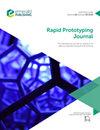基于GMA-DED的线弧增材制造中温度和残余应力的分布
IF 3.6
4区 工程技术
Q1 ENGINEERING, MECHANICAL
引用次数: 0
摘要
目的气体金属电弧定向能沉积(GMA-DED)工艺面临着一个重大挑战,即在连续的层沉积过程中,由于热量积累而产生的残余应力(RS)。为了解决这一问题,监测与时间有关的瞬态温度分布是一个关键输入。有限元分析(FEA)被认为是量化所有制造过程中的温度和RS的决定性工程工具。然而,计算时间和预测精度一直是GMA-DED过程中基于有限元分析的响应预测所关注的问题。因此,本研究旨在研究GMA-DED过程中有限元网格变化对所开发RS的影响。设计/方法/方法单元形状函数的变化,即线性和二次插值单元,已用于在Ansys参数化设计语言中对单轨10层薄壁构件进行建模。本研究提出了两种情况:情况1采用线性插值单元进行网格划分,情况2采用线性和二次插值单元的组合进行网格划分。此外,模型响应与通过温度和RS数据采集系统测量的实验结果进行了验证。结果表明,在预测值和实验值之间,温度和RS剖面具有良好的一致性。考虑到类似的参数,情况1的温度预测平均误差为4.13%,而情况2的温度预测的平均误差为23.45%。此外,比较情况1和情况2的横向纵向应力,误差分别为8.282%和12.796%。独创性/价值为了避免昂贵和耗时的实验方法,专家们建议在工程问题的设计优化中使用数值方法。然而,有限元分析方法是一种微妙的工具,它仍然面临着高计算成本和低精度的选择,基于选定的单元技术。这项研究可以作为选择元素技术的基础,该技术可以在GMA-DED过程的热机械建模中预测更好的响应。本文章由计算机程序翻译,如有差异,请以英文原文为准。
Distribution of temperature and residual stresses in GMA-DED based wire-arc additive manufacturing
Purpose
Gas metal arc-based directed energy deposition (GMA-DED) process experiences residual stress (RS) developed due to heat accumulation during successive layer deposition as a significant challenge. To address that, monitoring of transient temperature distribution concerning time is a critical input. Finite element analysis (FEA) is considered a decisive engineering tool in quantifying temperature and RS in all manufacturing processes. However, computational time and prediction accuracy has always been a matter of concern for FEA-based prediction of responses in the GMA-DED process. Therefore, this study aims to investigate the effect of finite element mesh variations on the developed RS in the GMA-DED process.
Design/methodology/approach
The variation in the element shape functions, i.e. linear- and quadratic-interpolation elements, has been used to model a single-track 10-layered thin-walled component in Ansys parametric design language. Two cases have been proposed in this study: Case 1 has been meshed with the linear-interpolation elements and Case 2 has been meshed with the combination of linear- and quadratic-interpolation elements. Furthermore, the modelled responses are authenticated with the experimental results measured through the data acquisition system for temperature and RS.
Findings
A good agreement of temperature and RS profile has been observed between predicted and experimental values. Considering similar parameters, Case 1 produced an average error of 4.13%, whereas Case 2 produced an average error of 23.45% in temperature prediction. Besides, comparing the longitudinal stress in the transverse direction for Cases 1 and 2 produced an error of 8.282% and 12.796%, respectively.
Originality/value
To avoid the costly and time-taking experimental approach, the experts have suggested the utilization of numerical methods in the design optimization of engineering problems. The FEA approach, however, is a subtle tool, still, it faces high computational cost and low accuracy based on the choice of selected element technology. This research can serve as a basis for the choice of element technology which can predict better responses in the thermo-mechanical modelling of the GMA-DED process.
求助全文
通过发布文献求助,成功后即可免费获取论文全文。
去求助
来源期刊

Rapid Prototyping Journal
工程技术-材料科学:综合
CiteScore
8.30
自引率
10.30%
发文量
137
审稿时长
4.6 months
期刊介绍:
Rapid Prototyping Journal concentrates on development in a manufacturing environment but covers applications in other areas, such as medicine and construction. All papers published in this field are scattered over a wide range of international publications, none of which actually specializes in this particular discipline, this journal is a vital resource for anyone involved in additive manufacturing. It draws together important refereed papers on all aspects of AM from distinguished sources all over the world, to give a truly international perspective on this dynamic and exciting area.
-Benchmarking – certification and qualification in AM-
Mass customisation in AM-
Design for AM-
Materials aspects-
Reviews of processes/applications-
CAD and other software aspects-
Enhancement of existing processes-
Integration with design process-
Management implications-
New AM processes-
Novel applications of AM parts-
AM for tooling-
Medical applications-
Reverse engineering in relation to AM-
Additive & Subtractive hybrid manufacturing-
Industrialisation
 求助内容:
求助内容: 应助结果提醒方式:
应助结果提醒方式:


